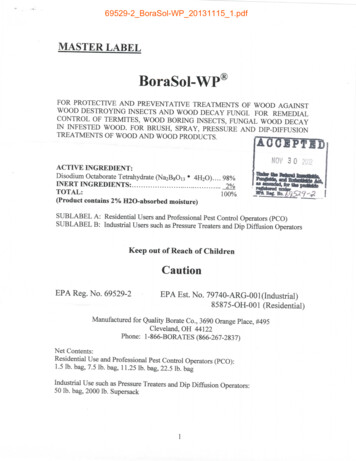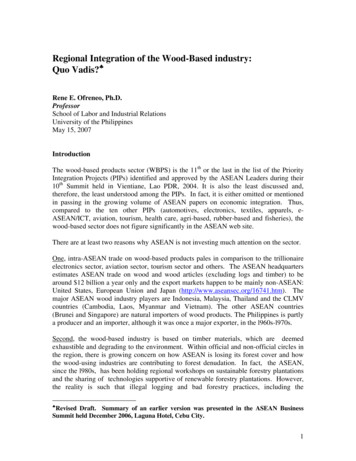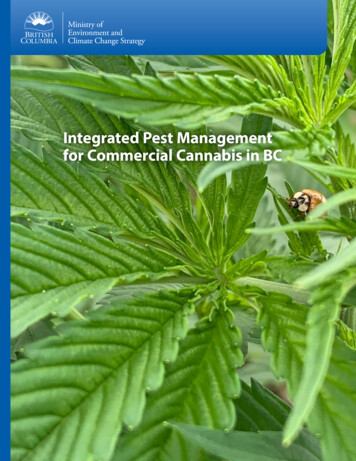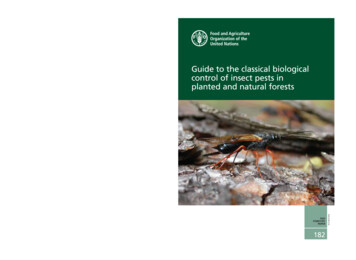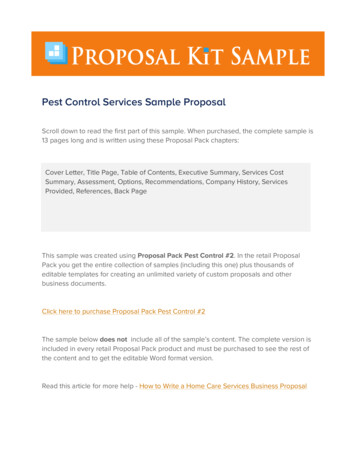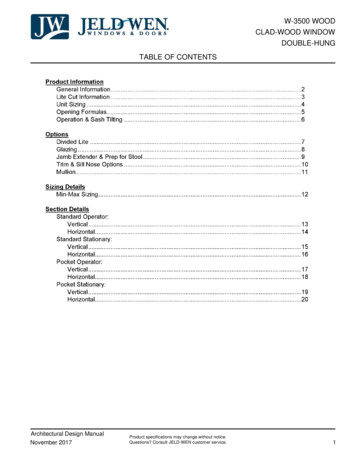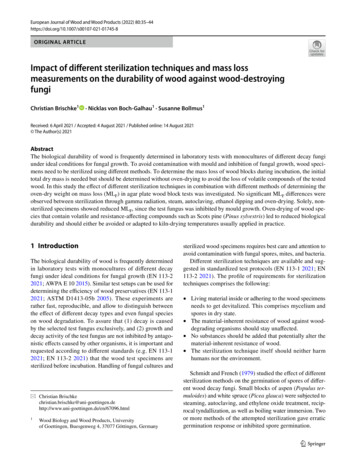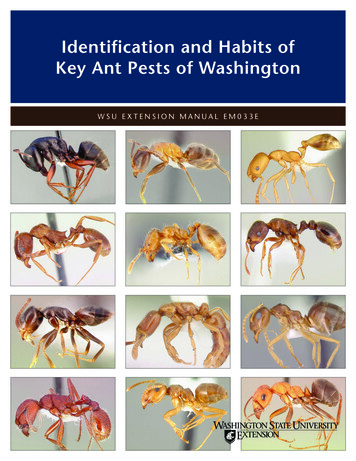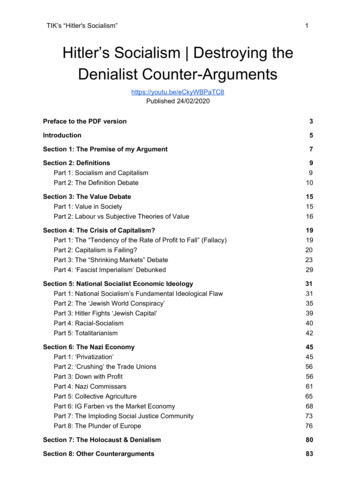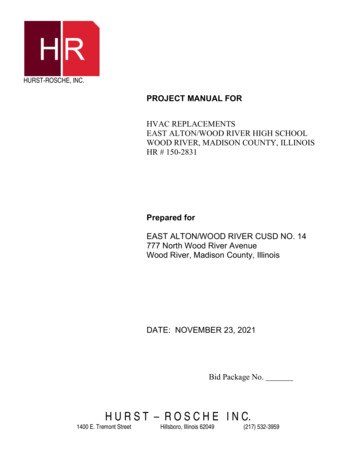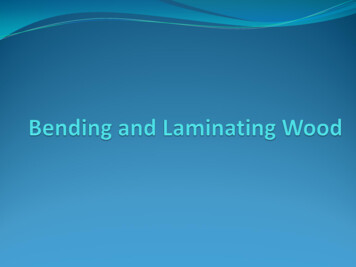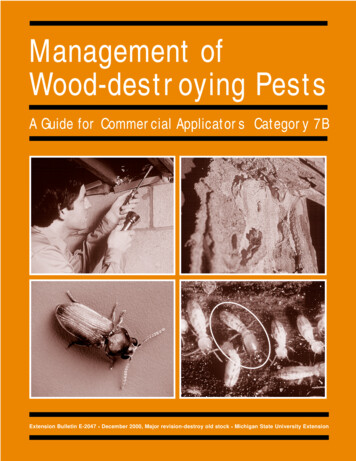
Transcription
Management ofWood-destroying PestsA Guide for Commercial Applicators Category 7BExtension Bulletin E-2047 December 2000, Major revision-destroy old stock Michigan State University Extension
Management ofWood-destroying PestsA Guide for Commercial ApplicatorsCategory 7BEditor:Carolyn J. RandallAcademic SpecialistPesticide Education ProgramMichigan State UniversityGeneral Pest ManagementiPreface
AcknowledgementsWe would like to express our thanks for the advice andtechnical assistance of the following reviewers: MarkSheperdigian, Rose Exterminator Co.; Val Smitter, SmitterPest Control; Jeffrey Zimmer, Michigan Department ofAgriculture; Mel Poplar, Michigan Department ofAgriculture; and John Haslem, former pest managementsupervisor at Michigan State University. We also thankRick Spencer of Master Pest Control and Bob Stoddard ofEnviroSafe for sending in their comments.Oklahoma Cooperative Extension Service. 1998.Structural Pest Control. Oklahoma State University.We acknowledge the main sources of text and illustrations for this manual: the Texas Agricultural ExtensionService manual, Control of Termites and Other Wood Pests,B-5075, Texas A&M University, 1999, and Truman’sScientific Guide to Pest Control Operations (fifth edition),G.W. Bennett, J.M. Owens and R.M. Corrigan, PurdueUniversity/Advantsar Communications Project, 1997.1Verrall, A.F., and T.L. Amburgey. 1979. Prevention andControl of Decay in Homes. U.S. Department of AgricultureForest Service anNd the Department of Housing andUrban Development: IAA-25-75.Sanders, D. 1987. Termite Pest Control, Including OtherWood-damaging Pests. Manual 96. University Extension,University of Missouri, Columbia.Smith, J.A. and N.R. Ehmann. Pest Control Library, Vol.IX: Wood-destroying Organisms (Other than Termites). VanWaters & Rogers, Inc., San Jose, California.We also acknowledge illustrations from slides obtainedfrom the Dow Chemical Corporation3 and the WestVirginia Cooperative Extension Service.4Other publications that were helpful in producing thismanual include:1Thefollowing illustrations were reproduced from Truman’sScientific Guide to Pest Control, 5th ed., copyright by AdvanstarCommunications, Inc: Figures: (some original drawings byArwin Provonsha, Purdue University): Figures 2.1, 2.2, 2.3, 2.4,2.6, 2.9, 2.13, 2.17. 2.18, 2.19, 3.1, 4.2, 4.3., 4.4, 5.3, 5.7, 5.8 and 6.1.Cutten, G.M. 1988. Termite Control in Ontario. Ministryof the Environment, Ottawa, Ontario.Koehler, P.G., and W.H. Kern, Jr. 1994. General HouseholdPest Control, Applicator Training Manual. University ofFlorida, Florida Cooperative Extension Service.2Thefollowing illustrations were reproduced from A Guide to theInspection of Existing Homes for Wood-inhabiting Fungi and Insects.U.S. Department of Agriculture Forest Service and theDepartment of Housing and Urban Development (IAA-25-75):2.15, 2.16, 7.1, 7.2, 7.3, 7.4, 7.5, 7.6, and 7.8Levy, M.P. 1975. A Guide to the Inspection of ExistingHomes for Wood-inhabiting Fungi and Insects. U.S.Department of Agriculture Forest Service and theDepartment of Housing and Urban Development (IAA25-75).3Thefollowing illustrations were reproduced from slides fromthe Dow Chemical Corporation: Figures 2.7, 2.8, 2.10, 2.11, 2.12,3.3, 3.4, 3.5, 3.10, 3.11, 3.13, 4.7, 5.1, 5.4, 5.5.Mallis, A. 1990. Handbook of Pest Control, 7th Edition.Franzak & Foster Co., Cleveland, Ohio.4Thefollowing illustrations were reproduced from the slide setSubterranean Termites—The Unwelcome Guests, 1981, West VirginiaCooperative Extension Service in Cooperation with USDA andUSEPA: Figures 2.14, 3.9, 3.12 and 3.14.Moore, H. 1979. Wood-inhabiting Insects in Houses: TheirIdentification, Biology, Prevention and Control. U.S. Departmentof Agriculture Forest Service and the Department ofHousing and Urban Development (IAA-25-75).New York State Cooperative Extension. 1987.Preservation and Treatment of Lumber and Wood Products.Pesticide Applicator Training Manual, Category 7. NewYork State College of Agriculture and Life Sciences,Cornell, University, Ithaca, N.Y.ContentsiiManagement of Wood-destroying Pests
Management of Wood-destroying PestsINTRODUCTION.VCHAPTER 3: EQUIPMENT AND METHODS.Termite Application Equipment . . . . . . . . . . . . . . . . .Sprayer Components . . . . . . . . . . . . . . . . . . . . . . . .Tanks . . . . . . . . . . . . . . . . . . . . . . . . . . . . . . . . . . .Pumps . . . . . . . . . . . . . . . . . . . . . . . . . . . . . . . . . .Hoses . . . . . . . . . . . . . . . . . . . . . . . . . . . . . . . . . .Applicators . . . . . . . . . . . . . . . . . . . . . . . . . . . . . .Drills . . . . . . . . . . . . . . . . . . . . . . . . . . . . . . . . . . .Calibration of Sprayers . . . . . . . . . . . . . . . . . . . . . . . .Preventing Contamination of DrinkingWater Systems . . . . . . . . . . . . . . . . . . . . . . . . . . . . . . . .Inspection of Wells . . . . . . . . . . . . . . . . . . . . . . . . . .Methods . . . . . . . . . . . . . . . . . . . . . . . . . . . . . . . . . . . . .Inspection . . . . . . . . . . . . . . . . . . . . . . . . . . . . . . . . .The Inspection Report . . . . . . . . . . . . . . . . . . . . .Prevention . . . . . . . . . . . . . . . . . . . . . . . . . . . . . . . . .Sanitation . . . . . . . . . . . . . . . . . . . . . . . . . . . . . . .Structural and Construction Defects . . . . . . . . .Barriers . . . . . . . . . . . . . . . . . . . . . . . . . . . . . . . . .Products Used in Termite Control . . . . . . . . . . . . .Pyrethroids . . . . . . . . . . . . . . . . . . . . . . . . . . . . . .Borates . . . . . . . . . . . . . . . . . . . . . . . . . . . . . . . . .Organophosphates and Carbamates . . . . . . . . .Insect Growth Regulators . . . . . . . . . . . . . . . . . .Biotermiticides . . . . . . . . . . . . . . . . . . . . . . . . . . .Foaming Agents . . . . . . . . . . . . . . . . . . . . . . . . . .Fumigation . . . . . . . . . . . . . . . . . . . . . . . . . . . . . . . .Advantages of Fumigation . . . . . . . . . . . . . . . . .Disadvantages of Fumigation . . . . . . . . . . . . . . .Bait Technology and ApplicationBait Placement . . . . . . . . . . . . . . . . . . . . . . . . . . .Commercial Baiting Products . . . . . . . . . . . . . . .Advantages and Disadvantages . . . . . . . . . . . . .Summary . . . . . . . . . . . . . . . . . . . . . . . . . . . . . . . . . . . .Review Questions . . . . . . . . . . . . . . . . . . . . . . . . . . . . .CHAPTER 1: LAWS CONCERNING CONTROL OFWOOD-DESTROYING PESTS . . . . . . . . . . . . . . . . . . . . . 1Protection: The Applicator’s Responsibility . . . . . . . .More Than Just Pesticide Application . . . . . . . . . . . . .State and Federal Laws . . . . . . . . . . . . . . . . . . . . . . . . .Federal Laws . . . . . . . . . . . . . . . . . . . . . . . . . . . . . . .FIFRA . . . . . . . . . . . . . . . . . . . . . . . . . . . . . . . . . .Endangered Species Act . . . . . . . . . . . . . . . . . . .OSHA . . . . . . . . . . . . . . . . . . . . . . . . . . . . . . . . . .State Laws . . . . . . . . . . . . . . . . . . . . . . . . . . . . . . . . .Michigan Occupational Safety andHealth Act (MIOSHA) . . . . . . . . . . . . . . . . . . . . .Natural Resources and EnvironmentalProtection Act . . . . . . . . . . . . . . . . . . . . . . . . . . .Regulation 636 . . . . . . . . . . . . . . . . . . . . . . . . . . .Regulation 637 Requirements . . . . . . . . . . . . . . .Summary . . . . . . . . . . . . . . . . . . . . . . . . . . . . . . . . . . . .Review Questions . . . . . . . . . . . . . . . . . . . . . . . . . . . . .11222222233366CHAPTER 2: THE BIOLOGY OF TERMITES ANDOTHER WOOD-DESTROYING PESTS . . . . . . . . . . . . . 9The Biology of Insects and their Relatives . . . . . . . . .Other Divisions Used in Classification . . . . . . . . .Growth and Development . . . . . . . . . . . . . . . . . . . . . .Growth . . . . . . . . . . . . . . . . . . . . . . . . . . . . . . . . . . .Development . . . . . . . . . . . . . . . . . . . . . . . . . . . . . .The Biology of Termites . . . . . . . . . . . . . . . . . . . . . . . .Termite Distribution . . . . . . . . . . . . . . . . . . . . . . . . .Subterranean Termites . . . . . . . . . . . . . . . . . . . . . . .Eastern Subterranean Termites . . . . . . . . . . . . . .Colony Formation . . . . . . . . . . . . . . . . . . . . . . . .The Termite and its Environment . . . . . . . . . . .Communication in the Colony . . . . . . . . . . . . . .Other Termites . . . . . . . . . . . . . . . . . . . . . . . . . . . . . .Drywood Termites . . . . . . . . . . . . . . . . . . . . . . . .Dampwood Termites . . . . . . . . . . . . . . . . . . . . . .Other Wood-destroying Insects and Pests . . . . . . . . .Powderpost Beetles . . . . . . . . . . . . . . . . . . . . . . .Longhorned Beetles . . . . . . . . . . . . . . . . . . . . . . .Black Carpenter Ants . . . . . . . . . . . . . . . . . . . . .Carpenter Bees . . . . . . . . . . . . . . . . . . . . . . . . . . .Wood-decay Fungi . . . . . . . . . . . . . . . . . . . . . . . .Key to Insect Damage of Wood-destroying Pests . . .Summary . . . . . . . . . . . . . . . . . . . . . . . . . . . . . . . . . . . .Review Questions . . . . . . . . . . . . . . . . . . . . . . . . . . . . .Management of Wood-destroying 323333333334343435CHAPTER 4: SOIL TREATMENT FORSUBTERRANEAN TERMITES . . . . . . . . . . . . . . . . . . . . 43Foundation Types . . . . . . . . . . . . . . . . . . . . . . . . . . . . .Slab-on-ground . . . . . . . . . . . . . . . . . . . . . . . . . . . .Crawl Space Construction . . . . . . . . . . . . . . . . . . . .Basement Construction . . . . . . . . . . . . . . . . . . . . . .Soil and Foundation Treating . . . . . . . . . . . . . . . . . . .Preconstruction Treatment . . . . . . . . . . . . . . . . . . . . . .Postconstruction Treatment . . . . . . . . . . . . . . . . . . . . .General Treatment Guidelines . . . . . . . . . . . . . . . . . . .Exterior Soil Treatment . . . . . . . . . . . . . . . . . . . . . .iii434444444445454545Contents
Exterior Slab Treatment . . . . . . . . . . . . . . . . . . . . . .Treatment of Foundation Voids inSlab Construction . . . . . . . . . . . . . . . . . . . . . . . . . . .Treatment of Brick or Stone Veneer . . . . . . . . . . . .Interior Treatment Methods . . . . . . . . . . . . . . . . . .Vertical Drilling . . . . . . . . . . . . . . . . . . . . . . . . . .Short Rodding . . . . . . . . . . . . . . . . . . . . . . . . . . .Long Rodding . . . . . . . . . . . . . . . . . . . . . . . . . . .Treatment Guidelines—Slab ConstructionSpecial Cases . . . . . . . . . . . . . . . . . . . . . . . . . . . . . . . . .Floating Slab Construction with Concrete Block .Foundation and Walls . . . . . . . . . . . . . . . . . . . . . . .Floating Slab Construction with ConcreteFoundation and Brick Veneer on Wood Frame . . .Monolithic Slab with Tile or TerrazzoFinished Floor . . . . . . . . . . . . . . . . . . . . . . . . . . . . . .Wood Over Slab . . . . . . . . . . . . . . . . . . . . . . . . . . . .Treatment Guidelines for Crawl Space ConstructionTreatment Guidelines for Basement Construction . . .Special Considerations—Basements . . . . . . . . . . . .Retreatments for Soil-applied Termiticides . . . . . . . .Termite Calculation Problems and Solutions . . . . . . .Summary . . . . . . . . . . . . . . . . . . . . . . . . . . . . . . . . . . . .Review Questions . . . . . . . . . . . . . . . . . . . . . . . . . . . . 565656666666667CHAPTER 6: OTHER WOOD-DESTROYING INSECTS 71Prevention of Wood-boring Beetles . . . . . . . . . . . . . . .Powderpost Beetles . . . . . . . . . . . . . . . . . . . . . . . . . . .True Powderpost Beetles . . . . . . . . . . . . . . . . . . . . .False Powderpost Beetles . . . . . . . . . . . . . . . . . . . .Furniture and Deathwatch Beetles . . . . . . . . . . . . .Control and Management of Powderpost Beetles .Inspection . . . . . . . . . . . . . . . . . . . . . . . . . . . . . . .Habitat Modification . . . . . . . . . . . . . . . . . . . . . .Pesticide Application . . . . . . . . . . . . . . . . . . . . . .Follow-up . . . . . . . . . . . . . . . . . . . . . . . . . . . . . . PTER 7: WOOD-DAMAGING FUNGI85.Wood-decaying Fungi . . . . . . . . . . . . . . . . . . . . . . . . .Brown Rot . . . . . . . . . . . . . . . . . . . . . . . . . . . . . . . . .White Rot . . . . . . . . . . . . . . . . . . . . . . . . . . . . . . . . .Soft Rot . . . . . . . . . . . . . . . . . . . . . . . . . . . . . . . . . . .Wood-staining Fungi . . . . . . . . . . . . . . . . . . . . . . . . . .Sapstaining Fungi . . . . . . . . . . . . . . . . . . . . . . . . . .Mold Fungi . . . . . . . . . . . . . . . . . . . . . . . . . . . . . . . .Chemical Stains . . . . . . . . . . . . . . . . . . . . . . . . . . . .Insects Associated with Wood-destroying Fungi . . . .Control and Management ofWood-destroying Fungi . . . . . . . . . . . . . . . . . . . . . . . .Inspection . . . . . . . . . . . . . . . . . . . . . . . . . . . . . . . . .Prevention . . . . . . . . . . . . . . . . . . . . . . . . . . . . . . . . .Habitat Modification . . . . . . . . . . . . . . . . . . . . . . . .Chemical Control . . . . . . . . . . . . . . . . . . . . . . . . . . .Prevention . . . . . . . . . . . . . . . . . . . . . . . . . . . . . .Control . . . . . . . . . . . . . . . . . . . . . . . . . . . . . . . . .Borates as Fungicides . . . . . . . . . . . . . . . . . . . . .Summary . . . . . . . . . . . . . . . . . . . . . . . . . . . . . . . . . . . .Review Questions . . . . . . . . . . . . . . . . . . . . . . . . . . . . .CHAPTER 5: OTHER TREATMENTS FORSUBTERRANEAN TERMITES . . . . . . . . . . . . . . . . . . . . 61Plenum and Non-plenum Crawl Spaces . . . . . . . . . .Subslab Heating Ducts . . . . . . . . . . . . . . . . . . . . . . . . .Special Considerations for Treating Basements . . . . .Dirt-filled Concrete Porch on a Frame House . . . . . .Wooden Porches . . . . . . . . . . . . . . . . . . . . . . . . . . . . . .Hollow Block, Tile, and Rubble Foundations . . . . . . .Wells, Cisterns, and Other Water Sources . . . . . . . . .Rigid Foam Insulation Board . . . . . . . . . . . . . . . . . . . .Wood Treatment . . . . . . . . . . . . . . . . . . . . . . . . . . . . . .Borates . . . . . . . . . . . . . . . . . . . . . . . . . . . . . . . . . . . .Wood Injection . . . . . . . . . . . . . . . . . . . . . . . . . . . . .Summary . . . . . . . . . . . . . . . . . . . . . . . . . . . . . . . . . . . .Review Questions . . . . . . . . . . . . . . . . . . . . . . . . . . . . .Wood-boring Weevils . . . . . . . . . . . . . . . . . . . . . . . . . .Longhorned Beetles . . . . . . . . . . . . . . . . . . . . . . . . . . .Control and Management of Longhorned BeetlesInspection . . . . . . . . . . . . . . . . . . . . . . . . . . . . . . .Habitat Modification . . . . . . . . . . . . . . . . . . . . . .Pesticide Application . . . . . . . . . . . . . . . . . . . . . .Follow-up . . . . . . . . . . . . . . . . . . . . . . . . . . . . . . .Carpenter Ants . . . . . . . . . . . . . . . . . . . . . . . . . . . . . . .Black Carpenter Ants . . . . . . . . . . . . . . . . . . . . . . . .Ant and Termite Swarmers . . . . . . . . . . . . . . . . . . .Control and Management of Carpenter Ants . . . .Inspection . . . . . . . . . . . . . . . . . . . . . . . . . . . . . . .Habitat Modification . . . . . . . . . . . . . . . . . . . . . .Pesticide Application . . . . . . . . . . . . . . . . . . . . . .Follow-up . . . . . . . . . . . . . . . . . . . . . . . . . . . . . . .Carpenter Bees . . . . . . . . . . . . . . . . . . . . . . . . . . . . . . .Control and Management of Carpenter Bees . . . .Summary . . . . . . . . . . . . . . . . . . . . . . . . . . . . . . . . . . . .Review Questions . . . . . . . . . . . . . . . . . . . . . . . . . . . . 1727273737474757576APPENDIX A:APPENDIX B:APPENDIX C:APPENDIX D:APPENDIX E:APPENDIX F:APPENDIX G:ivAnswers Appendix . . . . . . . . . . . . . . 95Glossary . . . . . . . . . . . . . . . . . . . . . . . 102Wood-boring Insects . . . . . . . . . . . . . 109Diagrams of Structural Members . . . 110Convenient Conversion Factors . . . . 111Bibliography . . . . . . . . . . . . . . . . . . . . 114Termites and OtherWood-destroying Pests . . . . . . . . . . . 115Management of Wood-destroying Pests
INTRODUCTIONHow to Use This ManualThis manual contains the information needed tobecome a certified commercial applicator in Category 7B,Wood-destroying Pests. This manual is intended for usein combination with the Pesticide Applicator Core TrainingManual (Extension Bulletin E-2195), available through theMichigan State University Bulletin Office. However, thismanual would also be useful to anyone interested inlearning more about the management of wood-destroyingpests.Category 7B, Wood-destroying Pests, covers the management and control of wood-destroying pests thatbecome problems in and around buildings. The chapterscontain basic scientific information as well as guidelinesfor practical solutions to pest control problems.The Category 7B certification exam will be based oninformation found in this booklet. Each chapter beginswith a set of learning objectives that will help you focuson what you should get out of the chapter. The table ofcontents will help you identify important topics andunderstand how they relate to one another through theManagement of Wood-destroying Pestsorganization of headings and subheadings. As you prepare for the exam, read each chapter and answer thereview questions located at the end. These questions arenot on the certification exam. They are provided to helpyou prepare for the exam. Questions on the exam will pertain directly to the learning objectives.The appendices and glossary, including an answer key(Appendix A), at the end of this manual provide supplemental information that will help you understand the topics covered in the chapters. Terms throughout the manualtext that are bold and italicized can also be found in theglossary.This certification manual benefits the applicator andthe general public. By learning how to handle pesticidescorrectly, applicators will be able to protect themselves,others, and the environment from pesticide misuse. Formore specific information on how to become a certifiedapplicator in Michigan, refer to the beginning of the coremanual (E-2195) or to the Michigan Department ofAgriculture’s Web site at http:\\www.mda.state.mi.us .vIntoduction
ContentsviManagement of Wood-destroying Pests
CHAPTER1LAWS CONCERNING CONTROL OFWOOD-DESTROYING PESTSmanagement professionals understand and keep up-todate with the laws that affect pesticide application insideor around buildings. Ignorance of the law is never anaccepted excuse for a violation.LEARNING OBJECTIVESAfter completely studying this chapter, you should: Understand why protecting the public and the environment from exposure to pesticides is the applicator’s responsibility.PROTECTION: THE APPLICATOR’SRESPONSIBILITY Know the role of a technician working in the pest control industry.Ultimately, responsibility for protecting the environment from the possible adverse effects of pesticide userests on the pesticide applicator. Preserving the biologicaldiversity of our planet by protecting the environmentcontributes to the overall quality of life. Each plant andanimal is part of a complex food chain; break one of thelinks and others are adversely affected. One disappearingplant can take with it up to 30 other species that dependon it, including insects, higher animals and even otherplants. Pest management technicians may see their normal work as unlikely to affect the environment, but spillsand leaks during mixing, loading, and transporting, orincorrect disposal can lead to pesticides in groundwateror surface water or in the habitat of non-target organisms.Pest management professionals often service nationalparks, schools, and other sensitive areas. Category 7B professionals have an even greater responsibility toward thepublic because they often work in or around buildings,where there is increased risk of exposing people to pesticides. All efforts should be made to achieve pest management goals through minimal use of pesticides in andaround buildings. When pesticides are used, they shouldbe applied in a manner that will prevent human contact. Understand the various state and federal laws thatgovern pesticide use, handling, and storage. Be able to explain the legal responsibilities of a pesticide applicator according to the rules of Regulation637. Describe the elements that should be included in thebasic training of a pest control technician.Pest management can be complex. It is a matter ofusing the right technologies and requires special equipment and safety measures. To be successful, it must beeffective and not adversely affect people or the environment. The number and variety of pesticides haveincreased and pest management professionals need toknow more about safety and proper use than ever before.For these reasons, among others, many state and federallaws and regulations have been adopted to help protectthe public, the environment, and pesticide handlers fromthe possible adverse effects caused by pesticide use. Inthis chapter, you will learn about the state and federallaws that regulate pesticide applicators, particularly commercial pesticide applicators certified in Category 7B,Wood-destroying Pests. Applicators certified in this category are responsible for pest management in and aroundstructures, including homes, schools, hospitals, businesses, warehouses, etc. It is important that Category 7B pestManagement of Wood-destroying PestsMORE THAN JUST PESTICIDEAPPLICATIONTo control pests, pest management professionals usemany other activities besides pesticide application. Theseother practices increase the effectiveness of the control1Chapter 1
General-use pesticides are those that anyone can purchasewithout restriction. Restricted-use pesticides can be usedonly by or under the direct supervision of a certified applicator. FIFRA also stipulates that persons who misuse pesticides (in a manner that is “inconsistent with the pesticidelabeling”) are subject to penalties.program and often reduce pesticide use or make such usea secondary operation of the program.An important area addressed throughout the manualis communication. Pest management is a service. Pestmanagement professionals must not only know their jobbut also be able to communicate effectively with theirclients. The pest management professional should be ableto explain the basic procedures to the client’s satisfaction.The client should feel confident that the pest management professional is able to meet his/her pest controlneeds safely and effectively. Also, the state of Michiganrequires that certain information must be communicatedto the customer (see Rule 12, Regulation 637).Endangered Species ActThis act requires the U.S. EPA to ensure that endangered or threatened plant and animal species are protected from pesticides. This act requires each pesticide label tolimit its use in areas where these speciescould be harmed. Category 7B applicators must consider the possibility thatendangered or threatened species maybe affected by pesticides applied in andaround buildings. The MichiganDepartment of Natural Resources(MDNR) Land and WaterManagement Division administersthe Michigan Endangered SpeciesAct (Act 451, Part 365) and maintains the federal and state endangered or threatened species lists.Michigan applicators who wantto be sure they are complyingwith the act must take the initiative and consult with theMDNR to be sure that there areno endangered or threatenedspecies in their area. One of thegoals of pest management is toprotect off-target plants and animals from pesticides, whether theyare endangered or not.STATE AND FEDERAL LAWSThe Pesticide ApplicatorCore Training Manual (E2195) discusses federaland state laws that governthe handling and use ofpesticides. Review thecore manual and understand how laws and regulations affect pesticidepractices and use. Theselaws include federal lawssuch as the FederalInsecticide,Fungicide,and Rodenticide Act(FIFRA), the OccupationalSafety and Health Act(OSHA), and the Endangered Species Act. State lawsinclude the Natural Resources and EnvironmentalProtection Act, Regulation 636, Regulation 637, and theMichigan Occupational Safety and Health Act(MIOSHA). These are just some of the laws that affectcommercial pesticide applicators. They are brieflydescribed below. Only Regulation 637 is discussed in further detail because of its particular relevance to Category7B. Refer to the core manual to learn more about otherlaws affecting pesticide use and for further details onlaws discussed in this chapter. Pest management professionals should keep up-to-date copies of the laws andreview their contents periodically. Copies of these lawscan be obtained from MDA regional offices.OSHAOSHA is administered by the U.S. Department of Labor(DOL). OSHA governs the record-keeping and reportingrequirements of all work-related deaths, injuries, and illnesses of businesses with 10 or more workers.STATE LAWSFEDERAL LAWSMichigan Occupational Safety and Health Act(MIOSHA)FIFRAto:The MIOSHA Right-to-Know act requires employers Obtain and retain material safety data sheets(MSDS) on all hazardous chemicals (including pesticides) for employee review.This is the basic federal law administered by theEnvironmental Protection Agency (EPA) that regulatespesticides—their use, handling, storage, transportation,sale, disposal, etc. FIFRA defines a pesticide as a substanceor mixture of substances intended to kill, repel, or mitigatea pest. The Michigan Department of Agriculture (MDA)has a cooperative agreement with the EPA to enforce someprovisions of FIFRA in Michigan. Some of the provisionsof FIFRA are that the EPA must register all pesticidesbefore they can be sold or used. The pesticides must beclassified as either “general-use” or “restricted-use.”Chapter 1 Develop and implement a written employee training program. Ensure that all containers of hazardous materialsare properly labeled.2Management of Wood-destroying Pests
Natural Resources and Environmental ProtectionAct, Act No. 451, Part 83, Pesticide Control637 establishes several legal standards for pesticide use.It requires that pesticides be used in a manner consistentwith their labels, that applications be made in a mannerthat prevents off-target discharges of pesticides, and thatpesticide application equipment be properly calibratedand in sound mechanical condition. The following discussion highlights some of the primary responsibilities ofCategory 7B pesticide applicators, according toRegulation 637. Obtain a copy of the entire regulation tounderstand the components of each rule and how yourpest management business and practices must comply.Rules 1-3 of Regulation 637 establish the definitionsand terms used throughout the regulation. Rule 4 outlines several activities surrounding the safe and legal useof pesticides. It states that a pesticide application must bemade in compliance with the following provisions:This legislation gives the director of the MDA authority to register or certify private and commercial applicators and to prescribe standards for certification and registration. Category 7B applicators are considered commercial applicators. Commercial applicators can be dividedinto two subclasses:Subclass A—Any person (including homeowners)who uses or supervises the use of restricted-use pesticides (RUPs) for a non-agricultural purpose.Subclass B—Any person who either (1) applies pesticides other than ready-to-use pesticides in the course ofhis or her employment, or (2) applies a pesticide for acommercial purpose (for hire).Ready-to-use pesticides are those used from the manufacturer’s original container (aerosols, pump sprays,strips, baits) with no need to mix or load into applicationequipment. A pesticide must be used in a manner consistentwith its label. Applications must be made so that off-target directdischarges are prevented. Pesticide application equipment will be in soundmechanical condition and be free of leaks and otherdefects that might cause a pesticide to be depositedoff-target or in a way inconsistent with its label. Application equipment must be properlycalibrated. Pesticide application or loading equipment that isdesigned to draw water must have an antisiphoning device. Applications shall not occur when conditions favoroff-target drift of pesticides or prevent the properdeposition of pesticide to the target area. Before applying a pesticide, the applicator willidentify any sensitive areas that are located adjacentto the target area and will use appropriate precautionary measures to prevent the direct discharge ofpesticides to those areas. Each vehicle that is used to transport pesticidesmust have the following information printed on itsexterior: Name of the pesticide applicator firm. Business telephonenumber, address, orU.S. Department ofTransportation census number of theapplicator firm. Any person whomixes, loads, or otherwise uses pesticides must haveimmediate access toa spill kit. The spillkit requirement doesnot apply to a personusing single containers of use-dilutionpesticides in a quantity less than 16ounces.Regulation 636 (Pesticide Applicators)This establishes the types of certified applicators andexpands the pesticide record-keeping requirements. Allcommercial applicators shall maintain records of pesticide use for a time period not less than the following:General-use pesticides: One year following application.Restricted-use pesticides: Three years following application.All records shall contain the following: The name and c
agement and control of wood-destroying pests that become problems in and around buildings. The chapters contain basic scientific information as well as guidelines for practical solutions to pest control problems. The Category 7B certification exam will be based on information found in this booklet. Each chapter begins
